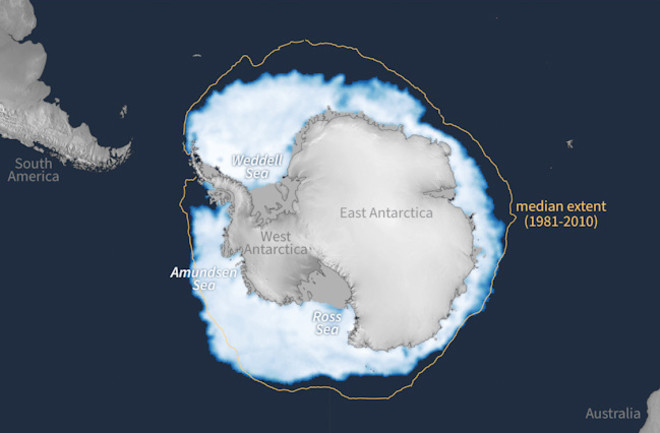As Antarctica plunges deeper and deeper into winter at this time of year, the frigid continent’s surrounding lid of floating sea ice should be expanding rapidly. But this year, sea ice has been growing at an agonizingly sluggish pace that has been setting records day after day.
“In the midst of its winter growth phase, Antarctic sea ice has reached a record smashing-low extent for this time of year,” according to the National Oceanic and Atmospheric Administration. “Sea ice extent is approaching a half a million square miles below the previous lowest extent, observed in 2022.”
Compared to the long-term average for this time of year, the seas around Antarctica were missing a million square miles of floating sea ice on June 27. That’s an area equal to four times the state of Texas.
Antarctic sea ice has been growing so anemically this winter that it has been setting records for lows on a daily basis since April.
Meanwhile, in the Arctic…
It’s now summer in the Northern Hemisphere, and sea ice in the Arctic has been shrinking. As temperatures warm, this is only natural. But Arctic sea ice has been shrinking more rapidly than normal. Although not at a record low, the extent of the region’s sea ice as of June 29 was 424,712 square miles below the 1981-2010 average — an area more than two and a half times the size of California.
Combining the anomalies of sea ice extent in the Arctic and Antarctic yields an unsettling picture that’s portrayed starkly in the graphic above. All told, as of June 29, the world was missing 1,417,821 square miles of sea ice.
Continuing the comparison to California, that’s an area equivalent to more than eight and a half times the size of the Golden State.
Is It Climate Change?
The Arctic has been warming four times as fast as the rest of the globe. And even considering natural ups and downs, sea ice in the region has been thinning and shriveling steadily. Here’s how that decline looks for the month of September, which is when Arctic sea ice reaches its annual minimal extent at the end of summer:
Scientists have clearly linked disappearing sea ice in the Arctic to human-caused climate change. But the story in the Antarctic is more complicated.
On the one hand, we have a continuing trend of sea ice declines. In addition to the record daily lows being set since April, back in February — at the end of the Antarctic’s summer season this year — sea ice shriveled to a record-low minimum extent. That beat the previous record low set in 2022.
On the other hand, Antarctic sea ice has recently been highly variable. While 2022 and 2023 both have had record low minimum extents, four out of the five highest have occurred since 2008. And overall, since satellite observations began in 1979, the trend in Antarctic minimum extent has been near zero, according to the National Snow and Ice Data Center.
Some scientists believe that what we’ve seen since 2022 may be signaling a significant and potentially long-lasting change. As Ted Maksym, a climate scientist and polar oceanographer at the Woods Hole Oceanographic Institution, put it in a recent story in Wired:
“Now there's this question about: Have we got into a regime shift? A few of us are sort of speculating that that may be true, where the variability in Antarctic sea ice has changed and we might see these low sea ice extents for some time.”
But Maksym also says he and his colleagues are “watching with bated breath” to see if things will return to normal — and they could. Scientists just don’t know.
That’s because the Antarctic is a very different environment than the Arctic — in a way that complicates drawing firm conclusions. The latter consists of an ocean surrounded by land, whereas the former is a giant landmass surrounded by oceans.
Sea ice around Antarctica is affected by a host of complex factors, including shifts in ocean currents and sea and air temperatures. Given how remote, forbidding and large Antarctica is, observations of these factors have been relatively sparse. Moreover, the record of satellite observations of sea ice dates only to 1979, making it difficult to separate out a human-caused signal from natural variability. And the sparseness of data, and the complexity of myriad factors, have made modeling of Antarctic sea ice very challenging.
Bottom line: Scientists haven’t seen anything like what’s been happening to Antarctic sea ice in the past two years. But it will take time to know whether a dramatic shift truly has occurred, and more research to tease out the role of anthropogenic climate change in what’s happening.

